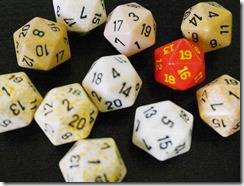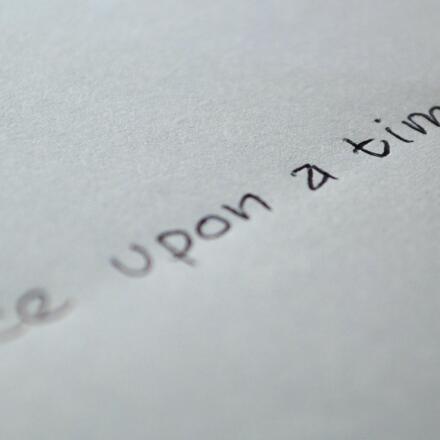 So you’ll often read online or hear during RPG discussions that someone’s dice were “misbehaving”, by which they usually mean they had a long string of low (usually, but sometimes high) numbers. It’s also regularly used as a reason why GMs fudge rolls as in: “I don’t usually fudge rolls, but the dice were misbehaving and we were close to a TPK…”. I personally have a love/hate relationship with dice. I enjoy crunching the math on die systems and figuring out optimal choices based on the probabilities involved, but when it comes time to belly up to the table, my dice very often run cold.
So you’ll often read online or hear during RPG discussions that someone’s dice were “misbehaving”, by which they usually mean they had a long string of low (usually, but sometimes high) numbers. It’s also regularly used as a reason why GMs fudge rolls as in: “I don’t usually fudge rolls, but the dice were misbehaving and we were close to a TPK…”. I personally have a love/hate relationship with dice. I enjoy crunching the math on die systems and figuring out optimal choices based on the probabilities involved, but when it comes time to belly up to the table, my dice very often run cold.
But of course, the dirty secret is that there is no such thing as misbehaving dice. There are only a hand-full of causes for so called “dice misbehavior” and they are all completely in the hands of the gamer. That said, let’s look into the causes and how you can counteract them.
- Faulty dice: While dice don’t misbehave per se, it’s entirely possible to have dice that don’t produce numbers according to the proper distribution. These dice aren’t misbehaving, but they’re not the dice you think they are either.  Here’s the results of an experiment on cubes of GW and Chessex d6s that showed they rolled 1 about 29% of the time. Those dice aren’t misbehaving, they’re rolling according to the distribution they’re made for, it’s just that that distribution isn’t the uniform distribution they were supposed to have. Oops!
So if you suspect that your dice simply aren’t generating the right set of numbers, what can you do? First, test them. The easiest way to do so is with a good old fashioned Chi-square goodness of fit test.* If they fail that test badly**, then it may well be time to follow Martin’s example and bury them in your back yard. - Strange runs: This is what most often convinces people their dice are misbehaving. They roll a bunch of 1s in a row or some other improbable feat. There are two things going on here, neither of which are your dice misbehaving. First, we tend to remember extreme results moreso than mediocre ones, so when you look back over your rolling for the night you may see runs of results that simply weren’t there. It’s just that you forgot all the boring results in between. Â Second, don’t forget that runs are rare, but they’re not all that rare and on a night where you roll your dice a hundred times, you have a decent shot at getting a short run or two. Software companies, who generate many more random numbers then we do over the course of a night, are well aware of this and often intentionally doctor their results if, for example, your ipad randomly selects 5 Sting songs in a row or your WoW character crits over and over.
So what do you do if you see too many runs, but you’ve already tested your dice and they seem to be rolling the correct distribution? There are two potential solutions here. The one I recommend is that you do nothing. Let the runs stand. They’re part of the normal flow of random numbers. However, you can do what the software companies sometimes do and save them for later. When you roll a particularly high or low roll, place your die on a marker of some sort. If next time you roll the same extreme, put down another marker. If you roll something else, remove all the markers.  At some houseruled number of accumulated markers, instead of placing one, you remove all the markers and nudge that roll toward more average results. Your run is broken. Either you or the GM gets a bennie (if your system has some sort of bennie system) or a token you can spend to nudge dice rolls later. - Too many extreme results: This is another common complaint. Dice roll willy-nilly with 1s and 20s all over the place. The level of random nonsense is just too damn high! Unfortunately, these dice aren’t really misbehaving either, providing they test fair. Instead you’re playing a system with too much variance in it’s results. Single dice generate numbers on a uniform distribution and uniform distributions tend to have a fair amount of variance compared to other types. Success/fail die pools for example follow the binomial distribution instead and have a much greater central tendency. Likewise rolling dice and adding the results tends to produce average results more often due to their central tendency. You can go to anydice.com and punch in some of the more common rolls in your system and get a histogram. The more the results look like a flat line the more variance is in your system. The more the results look like a normal curve, the less likely you are to see extreme numbers. Here are a few examples (1d20, 2d10, 3d6,5d4) that all produce more or less the same range of numbers:

You can see that by adding more dice, the chance of getting the most extreme results is reduced from 5% to ~.1% and the chance of getting the more average results go from 5% to ~15%.
So to fix this type of misbehavior, you could revamp your whole system to use sums or pools over single die rolls, but the impact of that to a system is likely to be fatal. Instead, it’s a better solution to simply switch to a new system that uses a die type that you like better.
So there you are: several common types of “die misbehavior” and how you can fix them. Did I miss any? Have you tried these or similar solutions in the past? How did they work out for you?
* As a fun side note: The chi-square goodness of fit isn’t really a test of randomness, it’s a test of distribution, so the following d4 rolls would pass just fine – 1111222233334444 or 1234123412341234. We don’t worry too much about patterns or runs with dice though because results are independent.
** Keep in mind that NO die is perfectly fair, and the more rolls you test with ANY test for fairness, the smaller deviation from the theoretically perfect distribution you’ll be able to catch. Don’t roll every die you own 10,000 times, bury them all in the backyard and be unable to game this weekend.

















I love your dice analysis. This is something a bit beyond my particular skillset, but I love seeing the numbers and reasoning for dice rolling how they do!
As a Savage Worlds GM I’ve snarled “well that die is obviously broken” and tossed the entire result when one of mine aces four or five times at the start of an evening to a player character’s detriment.
Of course everyone knows that isn’t the case, but it avoids bad feeling early on and sets the tone for the evening to “I’m not *trying* to kill anyone”.
My more usual problem is a known capacity to roll abysmally for long runs. My savage worlds villains can come to disappointingly short ends when I roll under four three times in a row on a D12.
And my Wonkhammer 401K fail rolls are legendary. In the 2001 Baltimore Tourney I fired my Tyranid Heavy Weapon 37 times and scored clean misses every time. One creature widely believed to be a “tough kill” died from a volley of hand lasers because my 2+ saves didn’t. By the end of the weekend I had opponents almost in tears begging me to take re-rolls (I refused, of course; when life gives you sucky dice rolls, declare yourself the King of Suck. Own the fail!)
Yes, I know the stats gods are not with or against me me, but when I play a rare game of WH40K I can pack a room with spectators laying bets on the number of 1s I’ll roll each throw.
If only I could figure a way to use these awesome powers for the forces of evil.
[EDIT] Are you aware that the page markup is somehow swallowing bits of your article? I’m reading with Firefox latest’n’greatest.[/EDIT]
I have some similar “war stories” myself. Like I said, I don’t believe in luck, BUT it sure feels that way. HOWEVER do keep in mind that study I linked above that shows Games Workshop and Chessex d6s rolling 29% 1s instead of the 16% it should be. Maybe our warhammer woes really ARE due to bad dice.
If so, according to other threads, you use these powers to your advantage by rolling THOSE dice for leadership and other “roll low” tests and a different set for roll high tests.
Also, thanks for the note about the formatting. I’ll pass it on to our tinker gnome.
You’d probably be amused by Jennifer’s solution: data! She has a little google form where she selects the die and reports the result. She’s building a “character’s lives are on the line” database, which everyone knows are more accurate than “rolling for fun”–because the big numbers only come out when they’re not helpful. Right? 😉
I’m pretty sure you can add another page to that Google form to keep a running chi square analysis of her rolls.
Most instances of “misbehaving dice” are almost certainly confirmation bias and human tendency to find patterns when none exist. We don’t remember the 19 we rolled on an unimportant perception check… just the 2 we rolled on the Death Save… and suddenly our dice are trying to kill us.
If you don’t agree that humans don’t understand randomness and probability, I refer you to a certain American city featuring laser-topped glass pyramids in an otherwise barely-habitable desert.
Or the lottery. I used to work in NY and their lotto slogan at the time (spouted by Louis Black, which is a bit ironic) was “You never know!” Every time I heard it, it made me seeth. I even had a student who was convinced she was going to win the big jackpot “someday soon” (because her psychic told her so of course) who would, after a class exercise calculating the dimensions of a pile of lottery tickets you would need to have a positive expected value of winnings would just shrug and say “You never know”.
Sorry, not positive expected value. I think it was just a pile the size of the denominator given in the official chances of winning. It was awhile ago. It’s a little fuzzy.
Hi Matthew,
Despite what it says on Tales of a GM, I do not actually punish my dice:
Dice Punishment
However, as a GM I make all my rolls in the open. Whenever I roll a 1 or 20, I swap over the die. Some sessions I only need one die, while others I seem to cycle through many dice.
As Roxysteve commented, this is about Player perception not randomness.
All the best
Phil
Well, on the one hand, I agree that this is mostly a perception problem.
On the other hand there IS some evidence that there are actually poor quality dice issues involved in SOME cases, so that may well bear checking out.
Then of course there’s the cases where even if it IS a perception problem it’s easier to slap a hotfix on it then to argue about the perception issue endlessly.
And then there’s the cases where the perception problem is stopping a group from moving to a new system where they would be happier because they don’t recognize the issue as being systematic and intentional.
There was just a post on the Facebook “Pathfinder RPG” page that dealt with testing d20’s – which, I am sure, would work with ANY opaque die.
Get a bowl or cup with salt water that is about twice as deep as the die you are testing. Toss the die in… look at what number comes up (and pay attention to the numbers immediately adjacent as well). Now, stick your finger in and spin the die – and watch what number comes up.
I tested all of my opaque D20s (over 25… I’ve been gaming a LONG time!), and more than 75% of them consistently came up with the SAME numbers – meaning that there were bubbles or core inconsistencies that skewed the results.
When I tested my clear or semi-transparent dice, they were fine.
Now I have to buy a butt-load of new dice… and you can bet they’ll all be clear!!